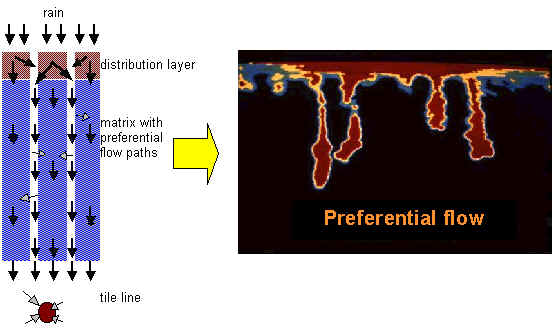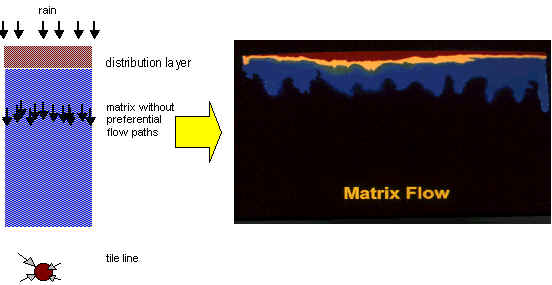|
|
|
WHY PREFERENTIAL
FLOW IS IMPORTANT?
Preferential flow refers
to the uneven and often rapid movement of water and solutes through
porous media, typically soil, characterized by regions of enhanced flux
such that a small fraction of media (such as wormholes, root holes,
cracks) participates in most of the flow, allowing much faster transport
of a range of contaminants, including pesticides, nutrients, trace metals,
and manurial pathogens. This creates significant consequences for ground-water
quality.
In 1980, residents of eastern
Long Island were dismayed to learn that approximately a thousand wells,
from which they got their drinking water, had been contaminated with Aldicarb,
a pesticide used to fight the Colorado potato beetle. Regulators familiar
with local conditions were as surprised as anyone, for they did not expect
the pesticide to get into the ground water so rapidly, nor in such high
concentration. Their conception of the fate of pesticides was clearly
inadequate.
Long Island’s problem
is not unique. During the last two decades, many studies have found high
concentrations of pesticides in tile lines or shallow ground water shortly
after application. Contamination of ground water with agricultural chemicals
is becoming a serious threat. Modern agriculture relies on a broad range
of fertilizers and pesticides to assure reliable crop yields, and although
integrated pest management may reduce the amount of chemicals needed,
a total ban is not currently feasible. A long-term hazard is involved:
once the chemicals get into groundwater, they may remain there for hundred
of years.
The high pesticide concentrations
are associated with preferential flow phenomena, which was initially described
in 1882, in a landmark paper by J.B. Lawes, J.H. Hilbert, and R. Warington.
During field drainage experiments, the authors distinguished between preferential
and matrix flows, and pointed out that the relative importance of the
two kinds of drainage depends on soil type and rainfall intensity. Preferential
flow refers to the uneven and often rapid movement of water and
solutes through porous media, typically soil, characterized by regions
of enhanced flux such that a small fraction of media (such as wormholes,
root holes, cracks) participates in most of the flow (Figure 1). Matrix
flow is a relative slow and even movement of water and solutes
through the soil while sampling all pore spaces, obeying the convective-dispersion
theory which assumes that water follows an average flow path through soil
(Figure 2). These two types of flow affected solute transport differently.
The chemical composition of preferential flow reflects the concentration
of water near the surface, while matrix flow represents the concentration
of water around the drain. Thus, when a salt is equally distributed throughout
the soil, the salt content of matrix flow is higher for water in preferential
flow paths, characterized by the rainfall composition. The opposite was
true (i.e., preferential flow had a higher solute content than the matrix
flow) when a fertilizer or tracer were recently surface applied. Consequently,
the solute concentration of drainage water depends on the ratio of water
in preferential and matrix flow paths.

Figure 1.

Figure 2.
Due to its rapid movement,
preferential flow allows much faster contaminant transport and creates
significant consequences for ground-water quality and has direct impacts
on drinking water and human health, animal waste management, nutrient
and pesticide management, and watershed management. In the mining sector,
the phenomenon of preferential flow has been used in designing the best
configuration for tailings left behind by mining operations. By including
clean material at strategic places where preferential flow is directed,
the toxicity of leachates can be greatly reduced.
Preferential Flow
|

